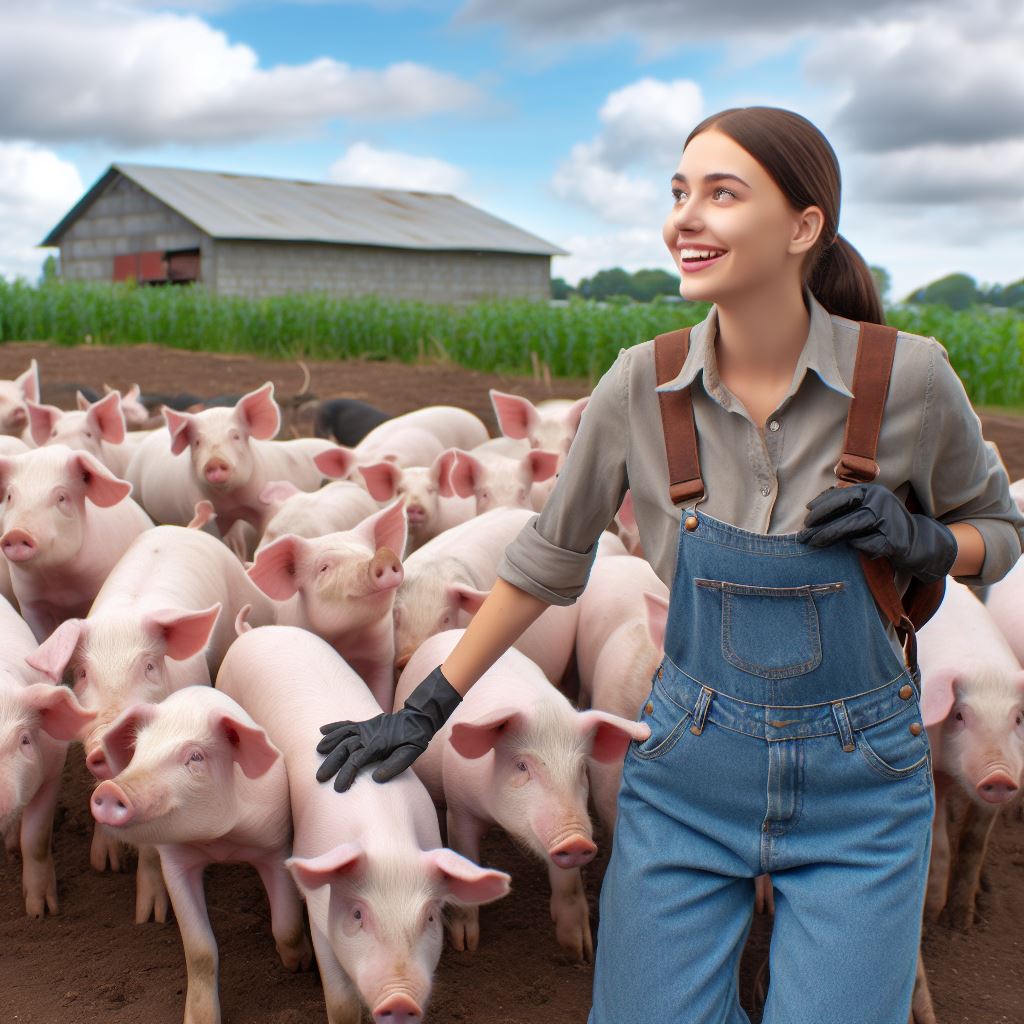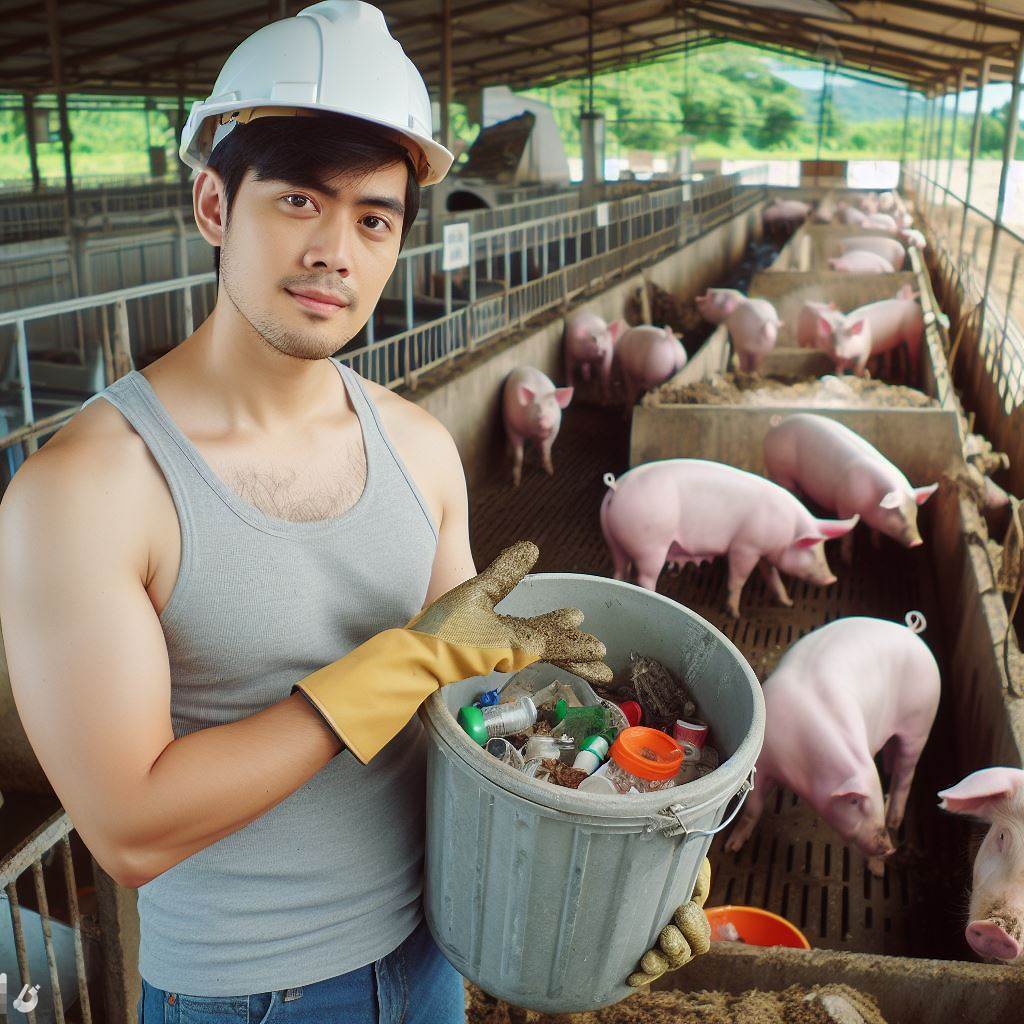Introduction
Poultry management plays a vital role in the successful operation of poultry farms.
It involves overseeing various aspects of poultry production, ensuring the well-being of birds, and maximizing profitability.
In this blog post, we will discuss the importance of poultry management and provide an overview of key techniques employed in the industry.
Importance of poultry management
Effective poultry management is crucial for several reasons.
Firstly, it ensures the optimal health and welfare of the birds, which directly impacts their productivity and overall performance.
Secondly, it helps maintain a clean and hygienic environment, minimizing the risk of diseases and infections.
Additionally, proper management practices contribute to the production of high-quality poultry products, meeting consumer demands.
Lastly, efficient management techniques help maximize profitability and ensure the long-term sustainability of poultry operations.
Overview of key techniques
Poultry management encompasses various techniques that are essential for successful poultry farming.
These techniques include proper housing and ventilation, efficient feeding and nutrition, disease prevention and control, biosecurity measures, flock management, and waste management.
Housing and ventilation practices ensure a comfortable and appropriate living environment for the birds.
Feeding and nutrition techniques aim to provide the right balance of nutrients to support growth and optimum performance.
Disease prevention and control measures involve vaccination programs, biosecurity protocols, and the use of preventive medication.
Effective flock management involves monitoring flock health, growth rates, and behavior.
Lastly, waste management techniques focus on proper disposal of manure and regular cleaning of facilities to maintain a healthy and sanitary environment.
Transform Your Agribusiness
Unlock your farm's potential with expert advice tailored to your needs. Get actionable steps that drive real results.
Get StartedIn conclusion, poultry management is crucial for successful poultry farming.
By implementing key techniques, farmers can ensure the well-being of their birds, produce high-quality products, and maximize profitability.
Housing and Environment
In poultry management, proper housing is of utmost importance for the well-being and productivity of the birds.
Adequate space and ventilation in the poultry house are crucial to prevent overcrowding and maintain air quality.
Optimal temperature and humidity levels should be diligently maintained to ensure the comfort and health of the poultry.
Lighting conditions play a significant role in the productivity and behavior of the birds.
Let’s delve deeper into each aspect to understand the key techniques for effective poultry management.
Importance of Proper Housing for Poultry
The housing system directly impacts poultry health, welfare, and overall performance.
- Provide a safe and secure environment to protect the birds from predators and adverse weather conditions.
- Proper housing helps in disease prevention and reduces the risk of infections and outbreaks.
- Good ventilation controls ammonia levels, removes excess moisture, and promotes fresh air circulation, preventing respiratory issues.
Providing Adequate Space and Ventilation
- Allocate sufficient space per bird to avoid overcrowding, which can lead to stress and reduced productivity.
- Ventilation is essential for removing airborne particles, excess heat, and humidity, creating a healthy and comfortable environment.
- Proper air exchange reduces the risk of respiratory diseases and ensures the availability of fresh oxygen for the birds.
Maintaining Optimal Temperature and Humidity Levels
- Monitoring temperature is crucial, as poultry are sensitive to extreme heat or cold.
- Provide a temperature-controlled environment, especially during brooding and extreme weather conditions.
- Maintain optimal humidity levels (around 50-70%) to prevent respiratory distress and feather-related issues.
Ensuring Suitable Lighting Conditions
- Proper lighting programs play a vital role in the growth, reproduction, and overall performance of the birds.
- Provide a consistent lighting schedule with suitable intensity and duration to stimulate natural behavior and egg production.
- Adjust the lighting period to promote proper rest for the birds, as they require a certain duration of darkness to rest and rejuvenate.
In summary, effective poultry management begins with providing proper housing and maintaining an ideal environment.
Remember to ensure space, ventilation, temperature, humidity, and lighting to promote the well-being and productivity of your flock.
Stay tuned for the upcoming sections in our blog series on poultry management for more essential techniques!
Feeding and Nutrition
Understanding the nutritional requirements of poultry
In poultry management, understanding the nutritional requirements of poultry is crucial.
To provide an appropriate diet, poultry diets are usually based on commercially formulated feeds.
These feeds are specially designed to meet the specific nutritional requirements of various poultry species and age groups.
Offering a balanced diet with appropriate amounts of protein, vitamins, and minerals
Providing a balanced diet is essential, ensuring appropriate amounts of protein, vitamins, and minerals.
A balanced diet typically includes a combination of grains, proteins, minerals, and vitamins.
The proportions of these components vary depending on the specific needs of the poultry.
Protein is a crucial nutrient for poultry. It is necessary for growth, egg production, and overall health.
Protein can be obtained from sources such as soybean meal, fish meal, and meat and bone meal.
Vitamins and minerals are also vital for poultry nutrition.
They support various bodily functions and help prevent deficiencies that can lead to poor growth, weakened immune systems, and reproductive issues.
Amino acids are another important aspect of poultry nutrition.
They are the building blocks of proteins and are essential for optimal growth and development.
Supplementing poultry diets with amino acids can improve overall performance.
Showcase Your Farming Business
Publish your professional farming services profile on our blog for a one-time fee of $200 and reach a dedicated audience of farmers and agribusiness owners.
Publish Your ProfileProviding access to clean and fresh water
One key aspect of poultry nutrition is providing access to clean and fresh water.
Poultry need a constant supply of water to stay hydrated and maintain their bodily functions.
Monitoring feed consumption and adjusting as needed
Monitoring feed consumption is also important.
By observing how much feed the poultry consume, we can gauge their health and adjust their diet accordingly.
This helps avoid overfeeding or underfeeding.
Overall all, Feeding techniques can also influence poultry nutrition.
For example, feeding the poultry small meals throughout the day can increase nutrient utilization and reduce wastage.
This strategy is especially useful for broilers and layers.
Feeds should be stored properly to maintain their nutritional value.
Moisture and pests can degrade feed quality, so storing feed in dry, clean, and rodent-free areas is necessary.
As the birds grow and develop, their nutritional needs change.
It is crucial to adjust their diet accordingly, ensuring that they receive the necessary nutrients at each stage of growth.
In essence, feeding and nutrition are critical aspects of poultry management.
Understanding the nutritional requirements, offering a balanced diet, providing clean water, and monitoring feed consumption are key techniques to ensure healthy and productive poultry.
Read: Sustainable Grazing: Balancing Land & Livestock
Disease Prevention and Biosecurity
In order to ensure the health and well-being of poultry, it is crucial to implement strict biosecurity measures to prevent disease outbreaks.
By following these key techniques, you can significantly reduce the risk of diseases affecting your flock:
Implementing strict biosecurity measures to prevent disease outbreaks
- Regularly inspect and strengthen the perimeter fencing to prevent unauthorized access.
- Control and limit visitors’ access to the poultry area.
- Strictly enforce proper handwashing and provide disinfecting stations at entry points.
- Use footbaths with disinfectants to prevent disease transmission.
- Properly train and educate all staff members on biosecurity protocols.
Vaccination programs and regular health checks
- Consult with a veterinarian to develop an effective vaccination schedule.
- Ensure all poultry are vaccinated according to the recommended schedule.
- Regularly monitor and record the health status of your flock.
- Perform routine health checks to detect any signs of illness early on.
- Isolate and treat sick birds promptly to prevent the spread of diseases.
Maintaining cleanliness and hygiene in the poultry area
- Regularly clean and disinfect all poultry housing and equipment.
- Remove and properly dispose of any dead birds or waste materials.
- Keep the poultry area well-ventilated to minimize humidity and moisture.
- Provide clean and fresh bedding material, such as straw or wood shavings.
- Regularly clean and sanitize feed and water containers.
Proper waste management to prevent disease transmission
- Implement a waste management plan to properly handle and dispose of poultry waste.
- Store and handle manure and litter in a manner that prevents contamination.
- Avoid spreading manure or litter near water sources or neighboring farms.
- Compost or properly treat waste to reduce the risk of pathogen transmission.
- Regularly clean and maintain drainage systems to prevent stagnant water accumulation.
By following these key disease prevention and biosecurity techniques, you can greatly reduce the risk of disease outbreaks in your poultry flock.
Remember, prevention is always better than cure when it comes to maintaining the health and productivity of your birds!
Read: Tech in Farming: Innovations in Livestock Care
Breeding and Reproduction
Selecting Healthy and Genetically Superior Birds for Breeding
- Identify birds free from diseases and physical abnormalities.
- Assess genetic traits such as egg production, body weight, and resistance to diseases.
- Choose birds with desirable characteristics to improve the overall flock.
- Consider the breed’s suitability for your specific production goals and environmental conditions.
Managing Breeding Programs and Maintaining Proper Male-to-Female Ratios
- Design breeding programs to achieve desired characteristics and maintain genetic diversity.
- Maintain an appropriate ratio of males to females for optimal fertilization rates.
- Regularly monitor and adjust the male-to-female ratio based on reproductive performance.
- Ensure sufficient space and resources for each bird to minimize aggression and stress.
Ensuring Appropriate Nest Boxes and Conducive Conditions for Egg-laying
- Provide clean and comfortable nest boxes to encourage egg-laying behavior.
- Ensure proper nest box dimensions to accommodate the size of the bird.
- Place nest boxes in secluded areas to provide privacy and a sense of security for the hens.
- Regularly check nest boxes for cleanliness and remove any broken or dirty eggs promptly.
Incubation Techniques and Managing the Hatching Process
- Collect eggs promptly and handle them carefully to prevent damage or contamination.
- Store eggs properly in a clean and cool environment before incubation.
- Use an appropriate incubation method, such as natural or artificial incubation, based on availability and requirements.
- Monitor temperature, humidity, and ventilation during incubation to ensure optimal conditions.
- Regularly inspect developing embryos and remove any non-viable or abnormal eggs.
- Prepare for hatching by creating a clean and warm environment, maintaining proper humidity levels.
- Monitor the hatching process closely, providing necessary assistance if required.
- Document hatch rates, chick quality, and other relevant data for future analysis and improvement.
Furthermore, By following these key techniques in breeding and reproduction, poultry managers can significantly improve the overall quality and productivity of their flocks.
The careful selection of healthy and genetically superior birds ensures the transfer of desirable traits to future generations.
Maintaining proper male-to-female ratios avoids issues related to low fertility or over-breeding.
Providing appropriate nest boxes and conducive conditions for egg-laying promotes the natural behavior of the birds and minimizes stress.
This, in turn, leads to higher egg production and better overall welfare.
In essence, mastering incubation techniques and managing the hatching process increases the chances of successful hatchings and results in healthy and robust chicks.
Poultry managers should always prioritize the health, genetics, and reproductive efficiency of their birds.
Correctly implementing these breeding and reproduction practices contributes to the long-term success and profitability of poultry operations.
Read: Livestock Disease Prevention: Must-Know Tips

Record-keeping and Monitoring
Importance of maintaining detailed records for each flock
- Keep track of important information about each flock to make informed management decisions.
- Detailed records allow for the identification of patterns and trends for better future planning.
- Accurate records help in documenting the history of the flock, which assists in diagnosing and treating diseases.
- It provides evidence of good practices and compliance with regulations and standards.
- Records aid in evaluating the success of different management techniques and making necessary improvements.
Tracking performance indicators like egg production, growth rates, and feed efficiency
- Monitoring egg production allows for timely adjustments to maximize productivity and profitability.
- Growth rates assist in determining if the flock is developing according to expectations.
- Measurement of feed efficiency helps optimize feed utilization, reducing production costs.
- Identifying variations in performance indicators helps identify potential issues and implement corrective actions.
- Comparing performance indicators across flocks aids in benchmarking and making informed comparisons.
Regular monitoring of birds’ health, behavior, and overall well-being
- Monitoring bird health ensures early detection and prompt treatment of diseases.
- Observing behavior helps identify stressors and adjust management practices to enhance bird welfare.
- Monitoring overall well-being helps detect signs of nutritional deficiencies or environmental challenges.
- Regular monitoring allows for proactive interventions and reduces the risk of disease outbreaks.
- Monitoring also provides valuable information on bird behavior and flock dynamics.
Utilizing technology and data analysis for efficient poultry management
- Implementing software or mobile applications for record-keeping streamlines data management and analysis.
- Automated data collection reduces the likelihood of errors and facilitates real-time access to information.
- Data analysis helps identify areas for improvement, such as adjusting feed formulation or vaccination programs.
- Advanced technologies like sensors and cameras can provide real-time bird monitoring, improving welfare and productivity.
- Data analysis enables data-driven decision-making, optimizing production and reducing costs.
Therefore, maintaining detailed records, tracking performance indicators, regular monitoring, and utilizing technology and data analysis are key techniques in efficient poultry management.
These practices ensure informed decision-making, maximize productivity, enhance bird welfare, and improve the overall profitability of poultry operations.
Read: Smart Fencing Solutions for Livestock Safety
Delve into the Subject: Goat Genetics: Improving Your Herd’s Quality
Conclusion
Recap of key techniques discussed
We have discussed several key techniques for poultry management.
These techniques include proper nutrition, biosecurity measures, flock health monitoring, and effective waste management.
Importance of implementing these techniques for successful poultry management
Implementing these techniques is crucial for successful poultry management.
They help improve productivity, minimize disease outbreaks, and ensure the overall well-being of the flock.
By practicing these techniques, poultry farmers can achieve better profitability and sustainability in their operations.
Furthermore, staying updated on advancements and best practices in the field of poultry management is highly encouraged.
Showcase Your Farming Business
Publish your professional farming services profile on our blog for a one-time fee of $200 and reach a dedicated audience of farmers and agribusiness owners.
Publish Your ProfileThe industry is constantly evolving, and new technologies and strategies are being developed to enhance efficiency and welfare.
By staying informed, poultry farmers can adapt to changes and make informed decisions for their businesses.
Encouragement to stay updated on advancements and best practices in the field.
In closing, poultry management requires a combination of knowledge, skills, and the implementation of key techniques.
By understanding and applying these techniques, poultry farmers can achieve optimal results in terms of productivity, flock health, and profitability.
Continuous learning and staying updated are vital in this dynamic field to ensure long-term success.




